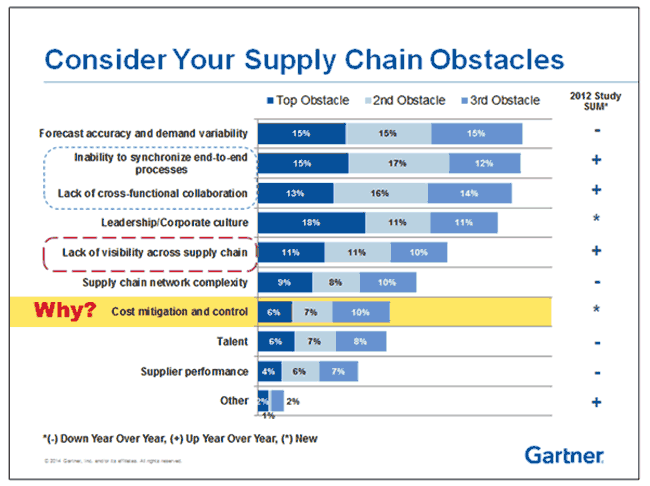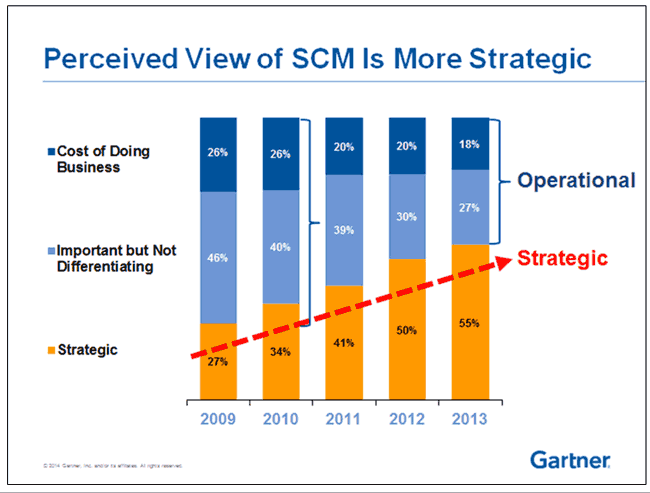Late last year into early 2014, SCDigest for the seventh time partnered with Gartner on what has become one of the major supply studies in the supply chain industry.
And the momentum keeps building, as the number of respondents to this moist recent survey reached about 500, a record for us and a very good number for these kinds of things - thank you.
I had to check with Garter analyst Dwight Klappich when he sent me this year's report, done in powerpoint fashion, because it sure didn't look much like the output in previous years. Klappich told me they had tried to make the data presentation more interesting this year, so Gartner changed the style quite a bit, which I think largely worked, though there are a few charts I liked a lot that have simply vanished. Alas. It's still good stuff.
So, I will summarize some highlights from this year's findings.
The research looked once again at obstacles to supply chain success. It is a little hard to say which is exactly seen as the top obstacle, based on the chart below, because you could define it different ways. Current "leadership and corporate culture" had the most votes for the number one barrier, at 18%, while "forecast accuracy and demand variability" receive the highest combined percentage across first, second and the third place, at 45%. That was just ahead of the combined 44% score for the challenge of synchronizing end-to-end processes.
Those three, plus a lack of cross functional collaboration, were all far ahead of the next group of supply chain barriers. For all the concern about supply chain talent, for example, it actually scored very low in the rankings.
In terms of supply chain stratgies, Improving supply chain visibility came in at the top, with 84% of respondents rating it as a top supply chain priority. That was followed by "improve business intelligence" (81%), which we can surmise as being connected to the whole advanced analytics movement, and then achieving "integrated business planning," at 74%.

Outsourcing, supply chain segmentation strategies, supplier rationalization and SKU rationalization scored at the lower end of the priority scale, though even those had somewhere near 50% of respondents saying they were important. Supply chain network design, government compliance, and globalization initiatives were in the middle, with about 60% saying they were important.
You have to wonder if a supply chain can really do so many things in parallel, given all these initiatives scored highy. I am tempted to say no, but admit after recently hearing about the rapid and incredibly broad supply chain transformations at 3M and Schneider Electric, maybe this many initiatives can in some cases be pursued in parallel.
One of the most eye-popping charts in the report is provided below, which shows the changes over time to how "strategic" supply chain is considered. As can be seen, the number of companies seeing supply chain as being strategic has risen sharply and consistently, from just 27% in 2009 to 55% in this study.

That is quite stunning, and has many ramifications: presumably better representation at the CXO level and perhaps even the board level; more investment dollars; more internal collaboration. I will write more relative to this soon – certainly it has become commonplace today for supply chain initiatives to be cited and discussed in much detail in quarterly earnings releases and analyst conference calls in recent years.
That said, the survey again found that expectations about future budget levels of supply chain investment were substantially higher (23%) for future years (2017) than the current year, which based on past surveys never seems to quite materialize when we get to those future years.
And respondents said that investment to reduce costs was more than twice as high as the spend to "transform" their supply chains. In other words, the tactical continues to outpace the strategic.
But really, rightly or wrongly, most companies make those kind of transformation efforts only once in quite a few years, whereas cost is an on-going pressure. Still, I remember Jake Barr, head of Procter & Gamble's supply chain until he retired last year, once discussing P&G's "continuous supply chain transformation" efforts, and I like that thinking too.
Not surprisingly, companies that say they are "aggressive" in terms of supply chain technology adoption are much more likely to invest to transformation or the strategic versus just to "run the business."
The aggressive companies spend about 20% for strategic efforts, versus about 14% for "mainstream" technology adopters, and just 10% for conservative companies.
And does that approach by aggressive companies pay off? There is no conclusive evidence, but the ratio of aggressive to conservative companies among level 4 respondents was 39 to 18, versus 2 to 69 among the least mature level 1 supply chains. But we need to do more work here.
The study also looked at Cloud-based supply chain applications, and had an interesting insight: the more advanced a company's supply chain is, the more likely it is to have acquired Cloud-based systems.
In fact, as shown below, only 18% of level 1 supply chains (least mature) are using some kind Cloud/SaaS solutions, versus 57% for the most mature level 4 companies. And while Gartner expects strong growth in both "private" and "public" Cloud deployments, it still expects roughly 60% of all supply chain software deals will still be in a traditional license model by 2021, down just a little from today's levels.

I believe Cloud will take a bigger share by then, as I have argued in the past. We'll see who is correct.
There is a lot more, but think I will wrap it up here. Good research. I might be able to drop you a copy if you send me a note at the Feedback link below.
Hope many of you will support the effort again at the end of the year.
Any reaction to this Gartner Suppyl Chain Report? Let us know your thoughts at the Feedback section below.
|